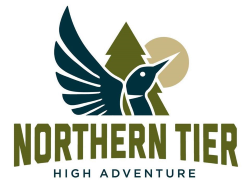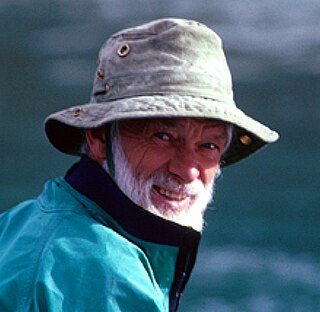
The Boundary Waters Canoe Area Wilderness comprises 1,090,000 acres (440,000 ha) of pristine forests, glacial lakes, and streams in the Superior National Forest. Located entirely within the U.S. state of Minnesota at the Boundary Waters, the wilderness area is under the administration of the United States Forest Service. Efforts to preserve the primitive landscape began in the 1900s and culminated in the Boundary Waters Canoe Area Wilderness Act of 1978. The area is a popular destination for canoeing, hiking, and fishing, and is the most visited wilderness in the United States.

Emily Pauline Johnson, also known by her Mohawk stage name Tekahionwake, was a Canadian poet, author, and performer who was popular in the late 19th and early 20th centuries. Her father was a hereditary Mohawk chief of mixed ancestry and her mother was an English immigrant.

Canoe camping, also known as touring, tripping or expedition canoeing, is a combination of canoeing and camping. Canoe campers typically carry enough supplies with them to travel and camp for several days via a canoe.

Quetico Provincial Park is a large wilderness park in Northwestern Ontario, Canada, known for its excellent canoeing and fishing. The 4,760 km2 (1,180,000-acre) park shares its southern border with Minnesota's Boundary Waters Canoe Area Wilderness, which is part of the larger Superior National Forest. These large wilderness parks are often collectively referred to as the Boundary Waters or the Quetico-Superior Country.

Northern Tier High Adventure is a collection of high adventure bases run by the Boy Scouts of America in the Boundary Waters Canoe Area Wilderness of Minnesota, Ontario's Quetico Provincial Park and Canadian Crown Lands, Manitoba's Atikaki Provincial Wilderness Park, Woodland Caribou Provincial Park, and points beyond. Northern Tier is the oldest of the four National High Adventure Bases operated by the Boy Scouts of America; the others currently in operation are Philmont Scout Ranch in New Mexico, Florida Sea Base in the Keys, and The Summit in West Virginia. The oldest, largest and most prominent of the Northern Tier bases is the Charles L. Sommers National High Adventure Base. Central to its programs is trips into the Boundary Waters Canoe Area Wilderness (BWCA) and Quetico Provincial Park

Bill Mason was a Canadian naturalist, author, artist, filmmaker, and conservationist, noted primarily for his popular canoeing books, films, and art as well as his documentaries on wolves. Mason was also known for including passages from Christian sermons in his films. He was born in 1929 in Winnipeg, Manitoba, and graduated from the University of Manitoba School of Art in 1951. He developed and refined canoeing strokes and river-running techniques, especially for complex whitewater situations. Mason canoed all of his adult life, ranging widely over the wilderness areas of Canada and the United States. Termed a "wilderness artist," Mason left a legacy that includes books, films, and artwork on canoeing and nature. His daughter Becky and son Paul are also both canoeists and artists. Mason died of cancer in 1988.

Duncan Campbell Scott was a Canadian civil servant and poet and prose writer. With Charles G.D. Roberts, Bliss Carman, and Archibald Lampman, he is classed as one of Canada's Confederation Poets.

Bowron Lake Provincial Park is a wilderness provincial park located in east-central British Columbia, Canada, near the border with Alberta. It is 117 km (73 mi) east of the city of Quesnel. Other nearby towns include Wells and the historic destination of Barkerville. Once a popular hunting and fishing destination, today the park is protected and known for its abundant wildlife, rugged glaciated mountains, and freshwater lakes.

Paddle-to-the-Sea is a 1941 children's book, written and illustrated by American author/artist Holling C. Holling and published by Houghton Mifflin. It was recognized as a Caldecott Honor Book in 1942.

Adventure fiction is a type of fiction that usually presents danger, or gives the reader a sense of excitement. Some adventure fiction also satisfies the literary definition of romance fiction.

The Children of the New Forest is a children's novel published in 1847 by Frederick Marryat. It is set in the time of the English Civil War and the Commonwealth. The story follows the fortunes of the four Beverley children who are orphaned during the war, and hide from their Roundhead oppressors in the shelter of the New Forest where they learn to live off the land.
Paddle to the Sea is a 1966 National Film Board of Canada short live-action film directed, shot and edited by Bill Mason. It is based on the 1941 children's book Paddle-to-the-Sea by American author and illustrator Holling C. Holling, and follows the adventures of a child's hand-carved toy Indian in a canoe as it makes its way from Lake Superior to the Gulf of Saint Lawrence, through Canada's waterways. It was nominated for an Academy Award for Best Live Action Short Film at the 40th Academy Awards.
Kevin Callan is a Canadian canoe enthusiast, media personality, and author of thirteen books, including the bestselling The Happy Camper and "A Paddler's Guide To" series.

Masterman Ready, or the Wreck of the Pacific is a robinsonade children's novel published in 1841 by Frederick Marryat. The book follows the adventures of the Seagrave family who are shipwrecked at sea, and survive on a desert island with the assistance of veteran sailor Masterman Ready.
Emilia Marryat was an English writer of children's books. The third daughter of the author Captain Frederick Marryat and his wife, Catherine, she followed her father's example by infusing her adventure novels with moral lessons. Occasionally, she published under her married name, Emilia Marryat Norris.

Canadian folklore is the traditional material that Canadians pass down from generation to generation, either as oral literature or "by custom or practice". It includes songs, legends, jokes, rhymes, proverbs, weather lore, superstitions, and practices such as traditional food-making and craft-making. The largest bodies of folklore in Canada belong to the aboriginal and French-Canadian cultures. English-Canadian folklore and the folklore of recent immigrant groups have added to the country's folk.

Mina Benson Hubbard was a Canadian explorer and was the first white woman to travel and explore the back-country of Labrador. The Nascaupee and George River system were first accurately mapped by her in 1905. She was the wife of Leonidas Hubbard who was famous for his ill-fated expedition to Labrador in 1903.

Gary and Joanie McGuffin are Canadian explorers, conservation photographers, writers, motivational speakers, documentarians and conservationists. Their most documented adventures have been about canoeing on waterways throughout North America, bicycling from the Arctic to the Pacific to the Atlantic oceans, backpacking the entire length of the Appalachian Trail, circumnavigating Lake Superior by canoe and paddling across Northern Ontario in the footsteps of Grey Owl. The McGuffins are noted primarily for their popular paddle sports instructional books on canoeing and kayaking, and their documentary film based on their research about the Group of Seven artists. Between adventures, the McGuffins are ambassadors of the wilderness, touring the world through speaking events, photo exhibitions, book tours, eco-tourism development, and educational seminars on conservation. In 2000, the Ontario government officially appointed Gary and Joanie as Champions of the Coast under the Great Lakes Heritage Coast program. In 2003, they were the recipients of the Premier's Award and the Queen's Golden Jubilee Medal for wilderness preservation and environmental education achievements for their province and their country.

David Hadfield is a Canadian singer/songwriter, author, wilderness adventurer, historic aircraft pilot, and classic-boat sailor. He shares writing credits on the album Songs From a Tin Can, recorded by his brother Commander Chris Hadfield, which is the first album of music recorded off the planet Earth.
Indigenous peoples of Canada are culturally diverse. Each group has its own literature, language and culture. The term "Indigenous literature" therefore can be misleading. As writer Jeannette Armstrong states in one interview, "I would stay away from the idea of "Native" literature, there is no such thing. There is Mohawk literature, there is Okanagan literature, but there is no generic Native in Canada".















